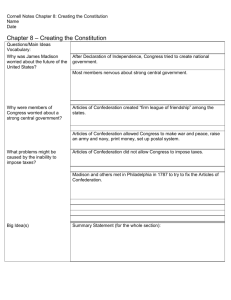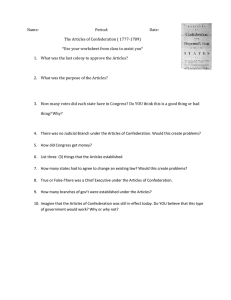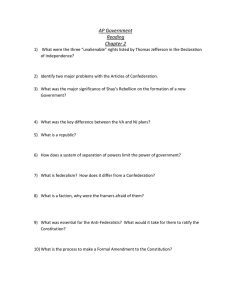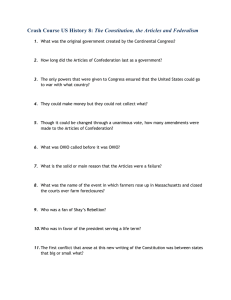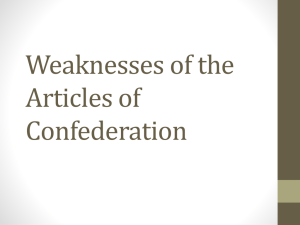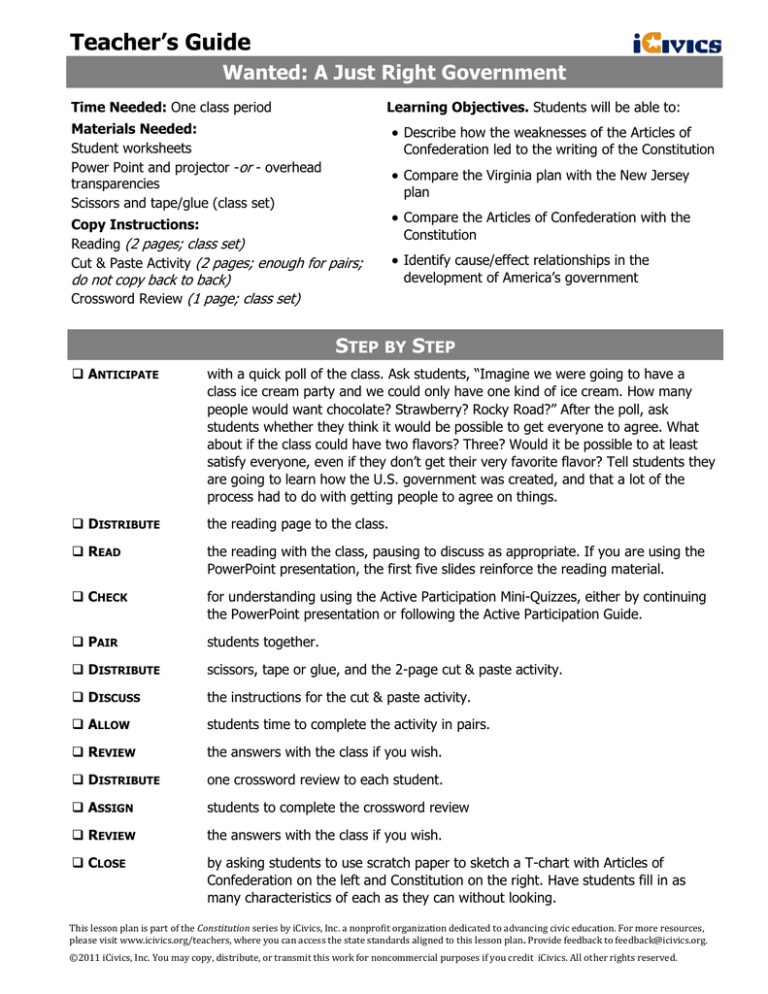
Teacher’s Guide
Wanted: A Just Right Government
Learning Objectives. Students will be able to:
Time Needed: One class period
Materials Needed:
Student worksheets
Power Point and projector -or - overhead
transparencies
Scissors and tape/glue (class set)
Describe how the weaknesses of the Articles of
Confederation led to the writing of the Constitution
Compare the Virginia plan with the New Jersey
plan
Copy Instructions:
Reading (2 pages; class set)
Cut & Paste Activity (2 pages; enough for pairs;
do not copy back to back)
Crossword Review (1 page; class set)
Compare the Articles of Confederation with the
Constitution
Identify cause/effect relationships in the
development of America’s government
STEP BY STEP
ANTICIPATE
with a quick poll of the class. Ask students, “Imagine we were going to have a
class ice cream party and we could only have one kind of ice cream. How many
people would want chocolate? Strawberry? Rocky Road?” After the poll, ask
students whether they think it would be possible to get everyone to agree. What
about if the class could have two flavors? Three? Would it be possible to at least
satisfy everyone, even if they don’t get their very favorite flavor? Tell students they
are going to learn how the U.S. government was created, and that a lot of the
process had to do with getting people to agree on things.
DISTRIBUTE
the reading page to the class.
READ
the reading with the class, pausing to discuss as appropriate. If you are using the
PowerPoint presentation, the first five slides reinforce the reading material.
CHECK
for understanding using the Active Participation Mini-Quizzes, either by continuing
the PowerPoint presentation or following the Active Participation Guide.
PAIR
students together.
DISTRIBUTE
scissors, tape or glue, and the 2-page cut & paste activity.
DISCUSS
the instructions for the cut & paste activity.
ALLOW
students time to complete the activity in pairs.
REVIEW
the answers with the class if you wish.
DISTRIBUTE
one crossword review to each student.
ASSIGN
students to complete the crossword review
REVIEW
the answers with the class if you wish.
CLOSE
by asking students to use scratch paper to sketch a T-chart with Articles of
Confederation on the left and Constitution on the right. Have students fill in as
many characteristics of each as they can without looking.
This lesson plan is part of the Constitution series by iCivics, Inc. a nonprofit organization dedicated to advancing civic education. For more resources,
please visit www.icivics.org/teachers, where you can access the state standards aligned to this lesson plan. Provide feedback to feedback@icivics.org.
©2011 iCivics, Inc. You may copy, distribute, or transmit this work for noncommercial purposes if you credit iCivics. All other rights reserved.
Wanted: A Just Right Government
Name:
Independent Citizens Seek Awesome Government
When the American colonists gained their independence from
the British after the Revolutionary War, the Americans were
faced with a problem: What kind of government should they
have? They’d lived for years under British rule, and they had
lots of complaints. Now they would create a government from
scratch, and they had a few requirements.
Independent Citizens Seek Awesome Government
Their experience under heavy-handed British rule left the newly independent
Americans a little bit skittish. Basically, they wanted a government that couldn’t
do much. They started by drafting a document called the Articles of
Confederation. A confederation is a group of individuals united together for a
purpose—in this case, the 13 states that had been British colonies before the
war. The Articles of Confederation explained how the 13 states would be
governed as one nation. Here are the basics:
Each state was independent and had its own government.
Each state would send representatives to the “Congress of the
Confederation,” a lawmaking body.
Benjamin Franklin worked on the
Articles of Confederation before
he helped write the Constitution.
Congress was the only branch of government. (No president or courts.)
In Congress, each state got one vote.
A Rocky Start
On one hand, the Articles of Confederation had qualities that citizens
appreciated. Because the Articles did not set up a very strong government,
states got to keep their power and independence. There was no powerful
government telling them what to do. Citizens also wanted protection, and the
Articles gave Congress the power to create a military to protect all the states.
However, there were problems. For one thing, the Articles did not give
Congress the power to enforce its laws. Congress also had no power to collect
taxes to pay for the military. And in order to change the Articles, every single
state had to agree to the changes. These and other problems meant that, in
general, citizens felt like the relationship… er, the government, wasn't working.
Lots of Differences
With thirteen different states, there was no easy solution. Here’s why:
States had different needs. For example, some states depended on fishing,
while others mostly grew crops.
States had different sizes. Some states had many people; others had few.
People had different opinions. Some people feared a central government,
while others thought a central government was necessary.
That last one was especially troublesome. Many people feared they would lose
their freedom if a central government had too much power. Others were tired
of the weak government created under the Articles of Confederation and felt
like nothing would ever get done if nobody was in charge.
Reading p.1
Wanted: A Just Right Government
Name:
Compromise?
The states decided to put aside some of their differences and come together to
try to solve the problem of forming another government. Some states floated a
new idea: Instead of a government with just one branch, Congress, why not
create a government with three branches? The new government could have a
legislative branch with a congress to make laws, an executive branch led by a
president to carry out laws, and a judicial branch with courts to interpret laws.
It sounded good, but one major sticking point kept it from moving forward:
How many votes would each state get in the Congress?
Voting in Congress: Yes, It’s a Big Deal
Why? Because some states have a large population and some have a small
population. Under the Articles of Confederation, each state got one vote no
matter how many people it had. That meant people in large states had less
influence in Congress. Naturally, large states thought this wasn’t fair. They
thought they should get more votes because they had more people. Small
states, however, thought it was a pretty good deal. Even though they were
small, they had the same amount of power and influence as large states.
They wanted to keep a one-vote-per-state system.
Battle of the Plans
Two different plans emerged—one favoring small states and one favoring
large states. Can you tell which is which?
Virginia Plan
New Jersey Plan
Legislative branch has 2 chambers Legislative branch has one
Number of votes for each state
chamber
depends on the state’s population Each state gets one vote
The Constitution Solution
The two sides—large states and small states—finally reached a
compromise. The Constitution was the second and final attempt to write
a document that would govern the United States, and we still follow it
today. Under the Constitution, Congress is divided in to two chambers: the
Senate and the House of Representatives. In the Senate, each state gets
two votes no matter what size it is. This favors small states. In the House
of Representatives, the more people a state has, the more votes it gets.
This favors large states. The Constitution also solved some other problems
found in the Articles of Confederation.
The Articles didn’t require states to treat citizens from other states the
The Americans were a lot like
Goldilocks in the story about the
three bears: They had to try
different governments until they
found one that was “just right!”
same as their own citizens, but the Constitution does.
The Articles couldn’t be changed unless all states agreed, but the
Constitution can be changed if 3/4 of the states agree.
The Articles didn’t require states to follow the laws Congress passed,
but the Constitution says federal laws are superior to state laws.
Reading p.2
Wanted: A Just Right Government
Name:
Cut & Paste Flow Chart
Wanted: A Just Right Government
Name:
It’s All About Cause and Effect! When you look at causes and effects, you can see the
relationships between different things that take place. Use what you learned in the reading to
match causes and effects for different stages of America’s government.
1) Cut out the causes and effects below.
2) Look at the three categories on the cause/effect flow chart.
3) Match three cause/effect statements for each category on the flow chart.
4) Paste the cause and effect statements onto the chart under the correct categories.
(Within each category, it doesn’t matter what order you paste them in.)
Cut & Paste Activity
Wanted: A Just Right Government
Name:
1
3
2
4
5
6
7
8
9
10
11
12
13
14
15
16
17
18
19
20
21
22
Across
3. Fraction of states that must agree to change the
Constitution
5. Under the Virginia Plan, these states would have more
power
7. The branch that makes laws
9. States must treat their own citizens and other states’
citizens this way
12. The branch that interprets laws
13. The document that replaced the Articles of
Confederation
16. One problem was that states charged these on goods
from other states
17. Under the Articles of Confederation, congress could
not do this to its laws, so states could just ignore
laws
19. The Articles let Congress create this but not pay for it
20. States send these to Congress
22. Under the Articles, America did not have one of these
Down
1. Early Americans had something in common with this fictional
character!
2. These were the “individuals” in the “confederation” created
by the Articles
4. Under the New Jersey plan, these states would have more
power
6. the branch that carries out laws
8. In the House of Representatives, the number of votes a
state gets depends on this
9. The chamber of Congress where each state gets two votes
10. A group of individuals united together for a purpose
11. The Articles of Confederation was America’s first plan for
_____.
14. One of two things people were afraid states might lose
15. The Articles of Confederation created a government that
had only one of these
18. The Constitution says laws passed by Congress are ___ to
state laws.
21. One of two things people were afraid states might lose
Crossword Review
Wanted: A Just Right Government ** TEACHER GUIDE **
_____
____.
_____
____.
_____.
____,
____.
Active Participation Projection Master
Wanted: A Just Right Government ** TEACHER GUIDE **
ACTIVE PARTICIPATION GUIDE
(PowerPoint Alternative for Print-only Users)
True/False Mini-Quiz. Read each statement aloud to the class. Have the class answer “True” or “False”
as a chorus or show you thumbs-up for true and thumbs-down for false. Listen or visually check for
inconsistent answers (indicating confusion). Use each statement as an opportunity for quick review.
1. The Articles of Confederation created a President to lead the country. (F)
2. States were still independent under the Articles. (T)
3. The Articles were easy to change. (F)
4. Under the Articles of Confederation, the more people a state had, the more votes it got in
Congress. (F)
5. The Congress created by the Articles did not have the power to collect taxes. (T)
6. Under the Articles, states had to obey the laws Congress passed. (F)
7. The Articles of Confederation created the first American government. (T)
8. When planning for the Constitution, everybody agreed the central government should have more
power. (F)
9. Some people were afraid states might lose their independence if the government was stronger.
(T)
10. Different states had different needs for government to meet. (T)
11. The states all got along with each other. (F)
12. The government created by the Articles of Confederation had everything under control among
the states. (F)
A/B Mini Quiz. Display the projection
master, showing the A/B chart.
Uncover one question at a time. Have
the class answer A or B as a chorus.
Here’s the key:
A
B
1.
executive
legislative
2.
the same
differently
3.
inferior
superior
4.
one chamber
two chambers
5.
Senate
House
6.
Senate
House
7.
All states
3/4 of states
Venn Mini Quiz. Display the projection master,
showing the Venn diagram. Read each characteristic
below aloud and have the class tell you where it goes.
Write the answers on the diagram as you go. (Just put
the letter of the statement on the Venn.)
A) Created a president (Constitution)
B) Created a government (Both)
C) Had one branch of government (Articles)
D) Had enough power to do its job (Constitution)
E) Created a court system (Constitution)
F) Gave large and small states the same power (Articles)
G) Created a Congress (Both)
H) Compromised between large and small states (Const.)
I) Created a military (Both)
J) Didn’t let Congress enforce its laws (Articles)
Active Participation Guide
Wanted: A Just Right Government ** TEACHER GUIDE **
Cause: The British government treated the
American colonists harshly.
Effect: Many American colonists feared a
powerful government.
Cause: Many former colonists feared losing
their freedom to a new government.
Effect: The new Americans made sure their
new government could not take away
states’ freedom and independence.
Cause: The British government taxed the
American colonists unfairly.
Effect: The new Americans made sure their
new government did not have the power to
collect taxes.
Cause: The government under the Articles
of Confederation could not collect taxes to
raise money.
Effect: The government could not pay its
debts from the Revolutionary War, and
America lost standing with other nations.
Cause: The legislature created by the
Effect: Large states were unhappy because,
Articles of Confederation gave equal power with bigger populations, they thought they
to large and small states.
should have more power.
Cause: The Articles of Confederation did
not create any courts.
Effect: When a problem arose between
states, there was nowhere to settle the
dispute.
Cause: Small and large states could not
agree on how power should be divided in
the legislature.
Effect: The new Constitution split the
legislature so states had equal power in one
half and power based on population in the
Cause: States could and did ignore laws
passed by the Congress created by the
Articles of Confederation.
Effect: The new Constitution said laws
passed by Congress are superior to state
laws.
Cause: Independent states made laws that
penalized out-of-state businesses and
citizens.
Effect: The new Constitution required states
to treat citizens of other states the same as
they treat their own citizens.
Cut & Paste Flow Chart
Wanted: A Just Right Government ** TEACHER GUIDE **
1
G
O
3
T H
R
E
E
F
O
U
R
T
H
2
L
10
T
D
4S
A
I
M
T
A
E
5
L A
G
C
E
L
K
8
S
12
P
C
9
O
U
E
P
T
N
J U
D
L
F
16
18
D
U
E
P
RE
21
PR
E
E R
7
C
E
6
X
N
20
R
0
O
S
TA
I
C
I
V
X
E
S A
A
M
L E
17
19
MI
L
I
T
A
R
11
L
13
N
T
A
T
I
V
S
L
A
T
N
S
T
14
EN
F
O
N
E
D
A
R
E
Y
N
N
P
C
M
E
E
S
H
E
N
N
D
T
E
R
B
CO
C
A
O
R
T
W
I
I
E
O
N
O
R
R
C
22
PR
E
I
V
E
I T
U
T
G
V
15
O
E
I
R
T
S
G
E
T
S
S
S
N
Across
3. Fraction of states that must agree to change the
Constitution
5. Under the Virginia Plan, these states would have more
power
7. The branch that makes laws
9. States must treat their own citizens and other states’
citizens this way
12. The branch that interprets laws
13. The document that replaced the Articles of
Confederation
16. One problem was that states charged these on goods
from other states
17. Under the Articles of Confederation, congress could
not do this to its laws, so states could just ignore
laws
19. The Articles let Congress create this but not pay for it
20. States send these to Congress
22. Under the Articles, America did not have one of these
I
D
E
N
I
O
N
E
Down
1. Early Americans had something in common with this fictional
character!
2. These were the “individuals” in the “confederation” created
by the Articles
4. Under the New Jersey plan, these states would have more
power
6. the branch that carries out laws
8. In the House of Representatives, the number of votes a
state gets depends on this
9. The chamber of Congress where each state gets two votes
10. A group of individuals united together for a purpose
11. The Articles of Confederation was America’s first plan for
_____.
14. One of two things people were afraid states might lose
15. The Articles of Confederation created a government that
had only one of these
18. The Constitution says laws passed by Congress are ___ to
state laws.
21. One of two things people were afraid states might lose
Crossword Review


